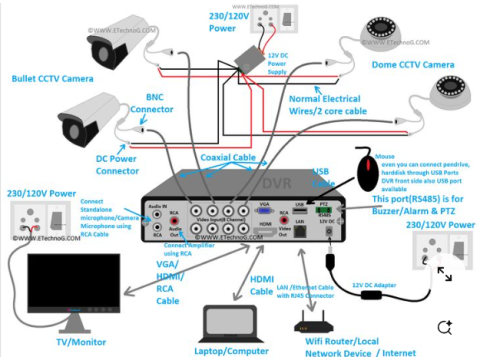Wiring Diagrams for CCTV Systems
The proper wiring setup is essential for any CCTV surveillance system. Below is a guide to typical configurations, focusing on analog systems, which remain widely used due to their simplicity and cost-effectiveness.
Components of a Typical CCTV System
A standard analog system typically includes:
- Cameras (anywhere from 1 to the maximum supported by the DVR or capture card)
- DVR (Digital Video Recorder), computer, or dedicated server for signal processing
- Monitors for video display
- Power Supplies for cameras and DVRs
- Network Adapters (optional for hybrid or remote monitoring setups)
- Audio Systems and Microphones (for sound recording and playback)
Basic Wiring Diagram for an Analog System
Camera Connections
Video Transmission:
- Coaxial Cable: Connects cameras to the DVR or capture device. This is a common and reliable method.
- Twisted Pair (Cat5e/6): Used with baluns to convert the signal, allowing longer cable runs.
Power Supply:
Cameras typically require 12V DC or 24V AC. Power is supplied either through individual adapters or centralized power boxes, depending on the system's scale.
DVR Connections
- Video Inputs: The DVR supports multiple video channels, with ports for each camera.
- Monitor Outputs:
- VGA or HDMI: Modern DVRs typically use these for high-resolution displays.
- BNC Composite: Used with specialized CCTV monitors or converters for standard monitors.
- Audio Outputs: For systems with sound recording capabilities, connect to speakers or amplifiers.
Power Supply for DVR and Monitors
- The DVR comes with its own AC adapter. Monitors usually plug directly into 220V outlets.
Special Configurations
Multi-Monitor Setup:
- Use a VGA splitter or HDMI extender to connect multiple monitors to the DVR.
Extending Video and Audio Lines:
- Use signal amplifiers or repeaters to maintain quality over long distances.
Hybrid Systems:
- Combine analog and IP cameras by using a hybrid DVR/NVR for seamless integration.
Additional Accessories
Modern surveillance setups often include tools to streamline connections:
- Splitters for video/audio signals
- Cable extenders to support long-distance installations
- Surge protectors to safeguard equipment from power spikes
Conclusion
Analog CCTV systems provide reliable and straightforward surveillance solutions. With the right wiring and connections, these systems can handle a variety of monitoring needs efficiently. For more advanced setups or hybrid systems, consult professionals to ensure optimal performance.

